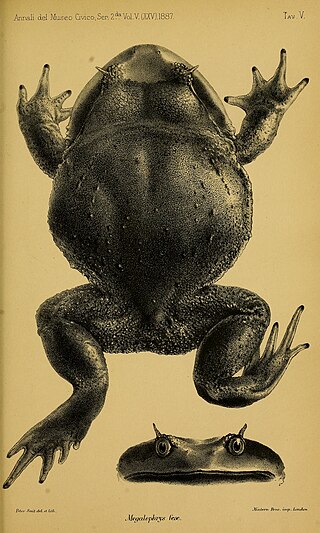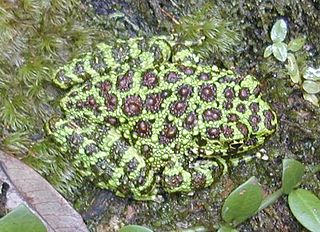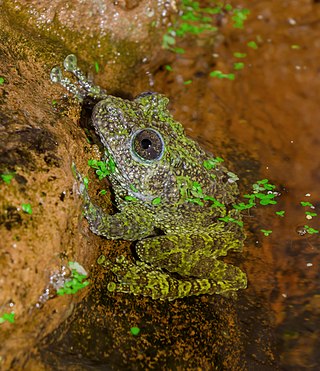
Brachytarsophrys is a genus of the family Megophryidae in the order Anura, and are found in southern China, Myanmar, northern Thailand and northern Vietnam. Common names include short-legged toad.
Poyntonophrynus grandisonae is a species of toad in the family Bufonidae. It is endemic to Namibe Province, Angola. Its range may be more widespread than currently known, including the nearby Iona National Park. It is only known from a few specimens because there has not been much research in the surrounding area, and thus its 2014 IUCN Red List of Threatened Species assessment remained at "Data Deficient".
Rhaebo hypomelas is a species of toad in the family Bufonidae. It is endemic to Colombia and known from the Chocó region in the departments of Antioquia, Chocó, Risaralda, Valle del Cauca, and Cauca, at elevations of 10–1,600 m (33–5,249 ft) asl. There are also reports from Ecuador but these are not considered valid. Its natural habitats are lowland tropical moist forests. It is a terrestrial species living in leaf litter near water. It is a rare species that is threatened by habitat loss.
Hyloxalus edwardsi is a species of frogs in the family Dendrobatidae. It is endemic to the Cordillera Oriental in the Cundinamarca Department, Colombia. It is named after Stephen R. Edwards from the University of Kansas Natural History Museum, a colleague of John D. Lynch who described this species in 1982.
Hyloxalus ruizi is a species of frogs in the family Dendrobatidae. It is endemic to Colombia and only known from the Eastern Ranges of the Colombian Andes, in the Cundinamarca Department. Its natural habitats are cloud forests. It occurs on the forest floor and along streams. It is threatened by habitat loss.
Hyloxalus vergeli is a species of frog in the family Dendrobatidae. It is endemic to Colombia and only known from the region of its type locality in the Cundinamarca Department, on the . Its natural habitats are cloud forests near streams. It tolerates some minor habitat disturbance.

Dryophytes eximius, commonly known as the mountain tree frog, is a species of frog in the family Hylidae endemic to Mexico. Its natural habitats are mesquite grasslands, scrub forests, and pine-oak forests. It is a widely distributed species that faces no major threats.

The Italian tree frog is a species of frog in the family Hylidae, found in Italy, Slovenia, Switzerland, and possibly San Marino. Its natural habitats are temperate forests, rivers, intermittent rivers, freshwater marshes, intermittent freshwater marshes, arable land, and urban areas. It is threatened by habitat loss.

Wright's mountain tree frog is a species of frog in the family Hylidae found in Mexico and the United States. Its natural habitats are temperate forests, temperate grassland, rivers, and freshwater marshes. Dryophytes wrightorum has been regarded as a synonym of Dryophytes eximius, the mountain tree frog, which is listed as the state amphibian of Arizona. As presently circumscribed, Dryophytes eximius is endemic to Mexico and does not occur in Arizona. It is the state amphibian of Arizona.
Strabomantis ingeri, or Inger's robber frog, is a species of frog in the family Strabomantidae. It is found on the eastern and western slopes of the Cordillera Oriental, Colombia. Its altitudinal range is 1,550–3,320 m (5,090–10,890 ft) asl. It might also occur in adjacent Venezuela. It is named after Robert F. Inger, an American zoologist from the Field Museum of Natural History.
Hypodactylus latens is a species of frog in the family Strabomantidae. It is endemic to the Cordillera Central of Colombia, and is known from the Antioquia, Caldas, Quindío, and Tolima Departments. Its natural habitats are sub-páramos and páramos at elevations of 2,690–3,350 m (8,830–10,990 ft) above sea level. It occurs on fallen leaves and grass roots. It is a rare species, although its cryptic habits might contribute to this impression. It is threatened by habitat loss (deforestation).
Gastrotheca antomia is a species of frog in the family Hemiphractidae. It is endemic to Colombia and found on the western versant of the Cordillera Occidental in Antioquia, Risaralda, Chocó, and Valle del Cauca Departments, at elevations of 1,140–2,500 m (3,740–8,200 ft) asl.
Hemiphractus johnsoni, or the Johnson's horned treefrog, is a species of frog in the family Hemiphractidae. It is endemic to Colombia and known from the Cordillera Central in Antioquia and Caldas Departments as well as from the Cordillera Oriental in Huila Department. Prior to 2001, what now is known as Hemiphractus helioi was included in this species. Its natural habitat is primary cloud forest. It is threatened by habitat loss.

Brachytarsophrys carinense is a species of frog in the family Megophryidae. It is now understood to include Brachytarsophrys platyparietus of China. Defined this way, its distribution area includes southern Myanmar and the adjacent Thailand and southern China.
Brachytarsophrys chuannanensis is a species of frogs in the family Megophryidae. It is endemic to southern Sichuan, China, in Junlian County and Hejiang County. However, the species may be more widespread than is currently known.

Brachytarsophrys feae is a species of amphibian in the family Megophryidae. It is found in southern China and northern Myanmar, Thailand, and Vietnam; it is likely to occur in Laos. The specific name feae honors Leonardo Fea, an Italian explorer, zoologist, and naturalist.

Ishikawa's frog is a species of frog in the family Ranidae. It is endemic to Okinawa Island, one of the Ryukyu Islands of Japan. It has been described as the most beautiful frog in Japan.
Raorchestes gryllus is a species of frog in the family Rhacophoridae. It is found in Laos and Vietnam. Its natural habitat is shrubby vegetation. It is presumably threatened by habitat loss.

Theloderma corticale is a species of frog in the family Rhacophoridae. It is found in northern Vietnam, south–central Laos, and southern China.









